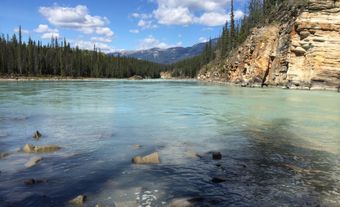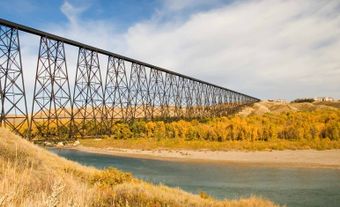
Course
The South Saskatchewan River is formed by the junction of the Bow and Oldman rivers, the headwaters of which are in the eastern slopes of the Rocky Mountains. It flows east to Medicine Hat, Alberta, and turns northeast, crossing the Alberta-Saskatchewan border before being joined by the Red Deer River, then opens up to Lake Diefenbaker, a 225 km long reservoir formed by the Gardiner Dam, and continues through Saskatoon, Saskatchewan, before reaching The Forks at the confluence with the North Saskatchewan River and beginning of the Saskatchewan River.
Flora and Fauna
The South Saskatchewan River begins in a prairie grassland environment, although its tributaries, the Bow and Oldman rivers, flow from Rocky Mountains headwaters through foothill forests to the prairie. The native prairie consists of grasses, including spear grass and wheat grass; however, much of the native grassland has been converted for agriculture. The river valley is dominated by cottonwood trees and shrubs, and increasingly home to invasive species, including bladder campion, leafy spurge, scentless chamomile, Canada thistle and perennial sow thistle. Prairie wetlands provide a breeding habitat for waterfowl and are home to balsam poplar, black spruce, jack pine, tamarack, aspen poplar, white birch and white spruce. Downstream of Saskatoon, as the prairie transitions to boreal forest, the vegetation shifts to willow, aspen and shrubs.
The South Saskatchewan River is home to warm-water fish species such as northern pike, walleye, goldeye, yellow perch, quillback, shorthead redhorse and the endangered lake sturgeon, while cold-water species such as several species of trout, mountain whitefish and longnose sucker inhabit upstream mountain tributaries. Mammals in the basin include black bear, elk, moose, mule deer, white-tailed deer, bison, beaver, muskrat, porcupine and a number of smaller mammals, and birds include several species of hawk, grouse, goose and owl, plus trumpeter swan, osprey and American white pelican.
Environmental Concerns
The South Saskatchewan River flows through an arid, but agriculturally productive and urbanized region of the Canadian prairies, and is subject to numerous environmental stressors that affect water quality and quantity. Much of the native prairie grasslands in the basin have been converted and wetlands drained for agricultural use. Wetlands are particularly important, as they provide habitats for migratory waterfowl and fish, naturally filter sediments and contaminants, and mitigate the effects of flooding. Water quality is negatively impacted by agricultural runoff, including pesticides and fertilizers as well as municipal wastewater and stormwater runoff to the river and its tributaries. Municipal wastewater can contain contaminants, including those from pharmaceutical and personal care products, as well as endocrine-disrupting compounds.
Streamflow is regulated by numerous dams and reservoirs in the river basin, one of which, the Gardiner Dam, is on the South Saskatchewan River itself. The dams and reservoirs are used for irrigation and hydroelectricity generation. Consequently, flow is higher than normal during the winter, coinciding with peak electricity demand, and lower than normal during spring as reservoirs are filled to meet summer water demands.
Water withdrawals in the South Saskatchewan River basin are the highest of any river basin in Canada, and since 2006 the basin has been closed to new water licenses in Alberta. Climate change is projected to further decrease already strained water availability and increase the frequency of droughts as well as the frequency and magnitude of flooding. Declining water quantity may result in inadequate in-stream flow requirements to sustain aquatic species, including fish and benthic invertebrates.
History
Indigenous people have inhabited the South Saskatchewan River basin for over 10,000 years, fishing from the river and hunting bison, woodland caribou, moose and small mammals. The river basin was home to a large population of bison until European settlement — which included the introduction of rifles and, eventually, railways — brought the bison population to near extinction. Bison jumps and pounds were common for large communal hunts performed between tribes. The largest historic jump — Head-Smashed-In Buffalo Jump — is in the Oldman River basin, a headwater tributary river to the South Saskatchewan.
The South Saskatchewan River basin includes the traditional territory of the Assiniboine, Cree and Ojibwa near the river’s confluence with the North Saskatchewan, the Blackfoot Confederacy to the west, and the Métis throughout.
In 1690–92, Henry Kelsey became the first European to reach the South Saskatchewan River, aided by First Nations guides. Kelsey paddled the upper South Saskatchewan, then travelled overland within the basin. David Thompson was the first European explorer to travel the extent of the South Saskatchewan and up the Bow River, a major headwater tributary. European exploration and settlement also brought diseases that decimated First Nations populations, including smallpox outbreaks in 1780, 1838, 1856 and 1869. In general, the North Saskatchewan was favoured over the South Saskatchewan for travel and trade.

 Share on Facebook
Share on Facebook Share on X
Share on X Share by Email
Share by Email Share on Google Classroom
Share on Google Classroom


